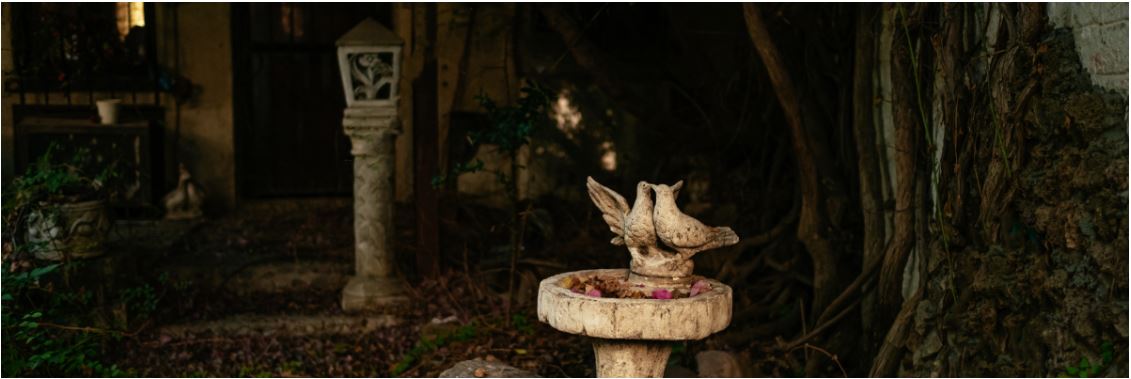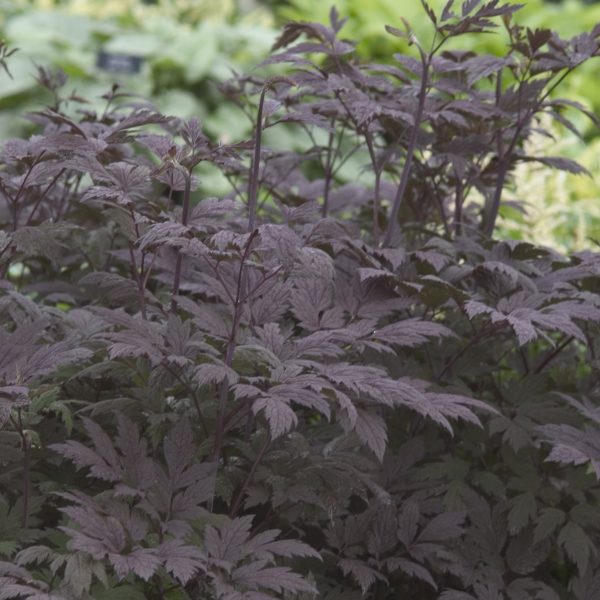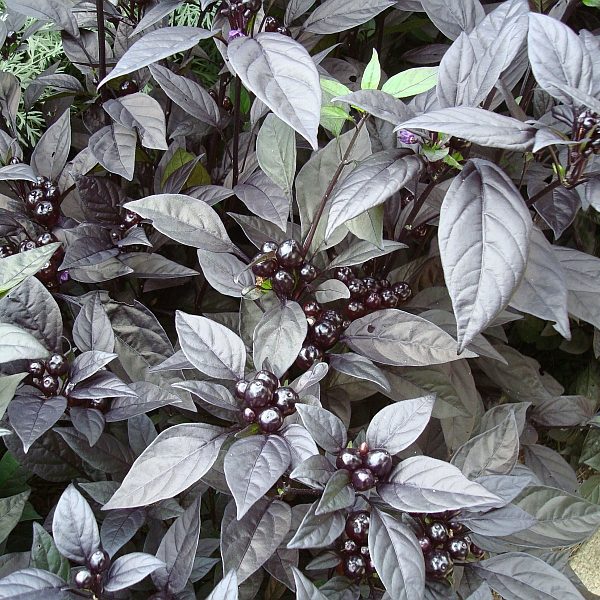Do you gravitate to graveyards, finding ancient tombstones creepily intriguing? Do you prefer reading Daphne du Maurier to Sophie Kinsella? Do you relish an antique aesthetic rather than farmhouse chic? If your personal taste leans more toward creepy, mysterious vibes than pretty, perky designs, then a goth garden may be the perfect solution for your outdoor space.
What is a Goth Garden?
Traditionally, gothic gardens—now referred to as “goth” gardens—incorporated themes of death and decay. Whether it’s a garden filled with mystical, medicinal herbs, a crumbling, forgotten courtyard with a tragic history, or a vine-covered, winding space with secretive, out-of-the-way rooms for tragic trysts, gothic gardens lend mystery and suspense to outdoor spaces.
Today’s goth gardens draw inspiration from the dark, brooding Victorian-era literature: think heroine fleeing her secretive husband, escaping through vine-covered, crumbling walkways, only to find herself trapped in a dark, mossy family cemetery—with a freshly dug grave! (Admit it: we all love a good, spooky story, right?!)
Goth gardens let you embrace your dark side with wickedly delightful elements that look terrific all year—not just for Halloween. If you want to create a garden with a gothic flair that will make the Brontë sisters proud, make sure to consider hardscaping, layout, plants, accessories, and lighting to create the perfect goth garden.
Hardscaping for your Goth Garden
Many of the most riveting gothic stories begin in an ancestral family home, with the rambling, often decrepit mansion providing the perfect backdrop to sinister happenings. While most of us reside in more modern homes, you can still create a goth atmosphere in your garden by focusing on hardscaping.
Hardscaping—man-made, non-living features—offer the perfect bones for your goth garden. Think of classic gothic features, and use hardscaping elements to add the desired dark ambiance. Classic gothic elements, like stone arches, elaborate wrought iron gates, ornate cast-iron borders, dark reflecting pools, and meandering paths to tucked-away garden rooms, provide a perfect foundation for creating the garden of your dreams—or nightmares.
Adding structures to your garden offers an opportunity to include historical elements to give your goth garden authenticity. Scour second-hand shops, architectural resale warehouses, and estate sales to find weathered, slightly crumbling stonework for paths or walls, pergolas with patina, and ancient arched doorways. Adding repurposed hardscaping gives your goth garden a sense of history—even if it’s brand new to you.
If you’ve found a shiny, new hardscaping element that fits your garden beautifully—but you’d like to make it look like it’s been in the garden for years–try yogurt!
Using a blender, mix one cup of plain yogurt with pieces of moss for about 30 seconds. Pour into a container, grab a paintbrush, and paint the yogurt/moss mixture onto walls, stones, statues…wherever you’d like to add an “aged” feel. Soon, you’ll notice a mossy covering creeping over your garden addition.
Layout of a Goth Garden
 |
 |
When considering the design of your goth garden, draw inspiration from classic gothic books and movies. The most harrowing stories include pathways that twist and turn as the heroine tries to escape; heavy, locked wrought-iron gates; pergolas covered in creeping vines; crumbling walls that imprison the ingenue. The more twists and turns you incorporate into the layout of your goth garden, the more intriguing it becomes. What’s behind the next curve? What (or who) is locked behind the heavy, keyless gate?
Creating the layout allows you to tell a story. Why ruin all the fun by showing a full garden view? Instead, create meandering paths that lead to pocket gardens, perfect for secret-sharing. Add a walled garden, accessible through a locked gate, filled with herbs—or toxic plants to create an evil vibe, if you like. (But if you have small children or pets, make sure to keep the gate locked.) For a truly goth feel, create a labyrinth—a maze built from hedges to lose yourself in.
Let your imagination run wild when you design the goth garden. Re-read your favorite gothic stories. (Check out Silvia Moreno-Garcia’s Mexican Gothic for a current novel set in a haunted ancestral mansion in 1950s Mexico. You’ll never look at mushrooms the same way again.) Watch your favorite gothic-inspired movie. Make notes of key creepy scenes that take place in the garden. And then, add your own flair to your garden layout. Think shadows, dark corners, paths that lead to…where? Keep it mysterious–and a little dangerous!
Avoid Straight Lines – Create an element of surprise when you design the layout of your goth garden. Avoid straight lines. Instead, plot twists and turns so visitors will wander and wonder what’s around the next bend.
Once you’ve created your layout and added the hardscaping elements to your goth garden, the fun really begins: it’s time to pick your plants!
Will you embrace an herbalist’s garden to create magical cures—or curses? What thick, vining plants will cover your pergolas, shading the walkways? Which dark flowers and foliage will create that slightly-sinister vibe, adding deep color and texture to your snaking paths and secret garden rooms?
Baptisia Dark Chocolate
Agave Black Widow
Heuchera Black Pearl
Ninebark Summer Wine Black
Plants for Your Goth Garden
The best goth gardens provide interest throughout the seasons, so choose plants that keep your goth garden looking great—in a spooky way—throughout the year.
Sedum Black in Black
Agave Black Widow
Harry Lauder’s Walking Stick
Fortunately, you’ll find an amazing array of plants perfect for adding the ideal atmosphere to your goth garden. From the deep, dark foliage of the National Garden Bureau Green Thumb Award Winner ‘Back in Black’ Sedum to the prickly, dangerous-looking Agave ‘Black Widow’ (with “hairs” reminiscent of the fine texture of a spider’s web) to the twisty-turns of Harry Lauder’s Walking Stick, you’ll find an abundant array of plants with dark flowers and foliage, interesting textures, and slightly spooky names to give your goth garden the perfect, creepy atmosphere.
Viola Sorbet® Black Delight
Helleborus Dark and Handsome
Hollyhock Black Knight
Calibrachoa Black Currant Punch™ Superbells®
Plants with dark, nearly black flowers
- Sorbet® Black Delight Viola
- ‘Black Magic’ Petunia
- Crazytunia® Black Mamba Petunia
- ‘Dark and Handsome’ Hellebore
- ‘Queen of the Night’ Tulip
- Black Knight Iris Germanica
- ‘Blacknight’ Hollyhock
- Supertunia® Royal Velvet®
- ‘Odessa’ Calla Lily
- ‘Black Baccara’ Rose
- Fritillaria persica
- ‘Zwartkop’ Aeonium
- Dark Chocolate Baptisia
Desana® Bronze Sweet Potato Vine
Winecraft Black® Smokebush
Andropogon gerardii Blackhawks
Cimicifuga ramose Hillside Black Beauty
Plants with Dark Foliage
- Coleus ‘Black Prince’
- Heuchera ‘Black Pearl’
- Canna Tropicanna® Black
- Grass Black Mondo
- Fringe Flower Sparkling Sangria™
- Ninebark Diabolo®
- Elderberry Black Lace®
- Weigela Dark Horse
- Weigela Tango
- Heuchera Northern Exposure™ Black
- Andropogen gerardii ‘Blackhawks’ grass
- Mangave ‘Black Magic’
- Sedum ‘Back in Black’
- Cimicifuga ramose ‘Hillside Black Beauty’
- Smoke Tree Royal Purple
- Smokebush Winecraft Black®
- Crapemyrtles Black Diamond Blooms
- Sweet Potato Vine Sweet Caroline Sweetheart Jet Black™
- Purple Fountain Grass
- Diervilla Kodiak® Black
- Sweet Potato Vine Desana® Bronze
Dark Opal Basil
Black Pearl Ornamental Pepper
Midnight Snack Tomato
Nearly black fruits and veggies
- Indigo Rose Tomato
- ‘Black Pearl’ Pepper
- Dark Opal Basil
- Spritzer Lettuce
- Black Krim Tomato
- Purple Beauty Peppers
- Black Spanish Radish
- Red Perilla Shiso
- Midnight Snack Tomato
- Chef’s Choice Black Tomato
Señorita Rosalita
Purple Wave
Purple Drama
Goth style containers
Even in an urban setting, you can add a touch of Goth with containers filled with dark flowers and foliage in black urns and containers.
Accessories
 |
 |
Along with plants, garden accessories show off your personality and preference for the macabre. Consider adding traditional gothic elements, like antique urns and statuary. Cherubs, saints, and angels serve the dual purpose of adding interest to the garden while making visitors’ necks tingle with a sense that they’re being watched. (If you’re a Doctor Who fan, you know Weeping Angels are terrifying.) A well-placed gargoyle tucked into a path is sure to startle a garden guest. Dragons add a mystical, mythical vibe to your garden as well.
A stone garden folly featuring the classic pointed arch shape common in gothic architecture makes an authentic addition to a goth garden. Add a fountain or urn to increase the dramatic appeal.
Rusty, cage-like outdoor lanterns hung from tree branches add a creepy aura, particularly when a candle within throws spooky shadows throughout the garden. (Of course, always keep an eye on burning candles.) You can just imagine your favorite heroine grabbing the lantern as she flees down the garden path.
Consider, too, adding a well-worn bench nestled under a pergola dripping with wisteria. After all, you’ll want a cozy place to escape to indulge yourself with your favorite gothic novels.
Lighting
If you really want to up the atmosphere ante in your goth garden, consider landscape lighting. Uplighting trees adds edgy mystery to the nighttime garden, creating creepy shadows that provoke the imagination. Spotlights on favorite garden statues showcase your art, while also giving life to inanimate objects, as shadows flicker across stone faces.
Consider adding pathway lighting to create drama along the meandering walkways of the garden, enticing visitors to explore the garden after dark…if they dare!
Creating a goth garden is limited only by your imagination. And, if you’re like most readers of classic gothic literature, your imagination is limitless. Enjoy your drama-filled garden all year long.























